You fill in the blanks. Several things could have happened here. In a perfect world, the horse is doing great. You have great energy and your horse and you are a real team. Best case, your trainer has also worked with you and your new horse to know what the trainer is doing so that you can all work on “the same page.”
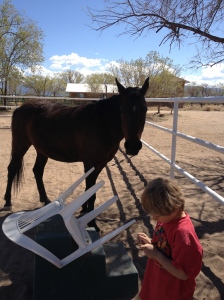
Many trainers like to work with the owner as well because that way, the owner can continue the work already started, the “conversation” that has begun with the horse. This is a good thing, and also the trainer can figure out where the horse and owner are not connecting. We all have blank spots, so it’s great to work with someone who notices what we don’t notice.
The horses that go to the trainer and come home sometimes have a problem transitioning. The training program is generally designed to put 30-60 days on the horse, and in that time, finding out any problem areas the horse might have. For the trainer, the horse will meet his expectations before the owner comes to pick him up.
The owner comes to pick up the horse. He or she rides the horse and everything goes well for awhile. Then maybe the owner doesn’t ride for awhile and the horse gets too frisky and forgets a lot of what he has learned. It could also be a personality clash. Sometimes the owner doesn’t keep up his leadership; that is one of the critical things that happens.
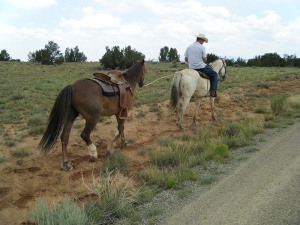 Years ago a trainer I knew sold a horse to a woman who didn’t know anything about horses. She had no leadership skills at that time. She rode him for awhile and complained that he would buck her off. The trainer came over and decided to “show that horse a thing or two,” got on him, and promptly got bucked into the fence. The horse had been on a dude string before coming to the trainer, and as it turned out, wasn’t happy with any non-dude string activity where he had to think for himself. He also was ready to take advantage of a green rider when the opportunity presented itself, even though he had had many of them in his life time. By the time the trainer got back to him, he had figured out how to unseat a rider very easily and the fact that the trainer was a trainer didn’t make any difference, he would fly too. Of course, that trainer’s ego was rightly bruised and he complained the woman had “ruined” his horse.
Years ago a trainer I knew sold a horse to a woman who didn’t know anything about horses. She had no leadership skills at that time. She rode him for awhile and complained that he would buck her off. The trainer came over and decided to “show that horse a thing or two,” got on him, and promptly got bucked into the fence. The horse had been on a dude string before coming to the trainer, and as it turned out, wasn’t happy with any non-dude string activity where he had to think for himself. He also was ready to take advantage of a green rider when the opportunity presented itself, even though he had had many of them in his life time. By the time the trainer got back to him, he had figured out how to unseat a rider very easily and the fact that the trainer was a trainer didn’t make any difference, he would fly too. Of course, that trainer’s ego was rightly bruised and he complained the woman had “ruined” his horse.
Very often trainers have a certain energy that allows them to be able to perform with horses who won’t perform that way with everyone. A lot of energetic work that takes place in training isn’t talked about, but is necessary to the relationship. A trust is built between trainer and horse that goes beyond the initial “relationship.” Good trainers possess “leadership” and/or “intent,” and also may expect more in terms of performance from a horse than the owner will expect. Many people who want a horse of their own to ride do not take into account the importance of their own energy in their relationship with their horses.
Leadership, body language, energy and trust building create the environment for people to form working bonds with horses. Those who want to short cut that process will end up with less of a relationship.
Sometimes the new owner will say, “he was supposed to be bomb-proof.” It’s an “I want my money back” type of statement. What does he do or not do? Not safe on the trail, doesn’t do flying lead changes, doesn’t longe without pulling your arms out of their sockets, doesn’t take up the right lead, side pass?
Some horses get sent to the trainer because they won’t do something, like pick up a lead, do canter departs, and other skilled moves like these. The reason can be because the horse is sore somewhere, but he might do the move for the trainer because he feels he must or the trainer makes it easier for him to do physically. The physical aspect really needs to be addressed. The horse will go against his instinct with the person he’s not as comfortable with sometimes and show his owner that he is not comfortable with the soreness in his body, and would she please do something to fix it?
The horse really needs his owner in his corner when it comes to training. There are a lot of methods out there that are advertised under the mantle of “gentling” that aren’t gentle at all. It’s important to find out whether your horse is challenging you or the trainer because he is misunderstood, in pain, or otherwise unable to do something.
I really like to know what the trainer is doing with my horse so that I can help my horse along with the transitions. I want to feel that person’s energy and see how my horse responds to him or her. I hear too many stories about discontent after the horse gets back home, so I probably wouldn’t send one of my horses away to a trainer. I would have the trainer work at my place. I would ask a lot of questions, especially if I see some techniques that I’m not sure are good for my horse. Why is this the direction you are taking with the horse? Maybe he needs a little more time?
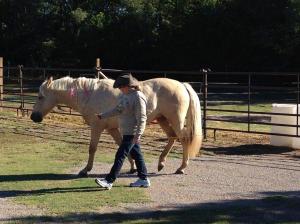
I remember a trainer getting angry at one of my horses because she whirled when a noisy truck came down the driveway. The trainer’s response was, “she should not be acting like such a baby, she’s too old for that. It’s just a truck.” That might be what we humans may think, but this was a horse who had not seen many vehicles in her lifetime up close, and mechanical manmade locomotives scared her. She was even afraid of the wheelbarrow. It would be good for her to be able to get through her fear of such things before being expected to “stop acting like a baby.” There is no set age for a horse to accomplish anything, even weaning. Just like people, they are on their own time schedule, and a lot depends upon how and what they have been exposed to in the past.
Before leaving your horse at the trainers, if you have to, notice how your horse feels about individual people, visitors, trimmers, vets, etc. This may be one of the first steps to finding out who is right for your horse. Horses are more sensitive on different levels than humans, and a lot can be learned by listening to them about their preferences.
If you need to leave your horse at the trainer’s, or you also get to work with your horse at the trainer’s, here is a checklist for help determine whether your horse is comfortable:
1) Does he or she seem himself?
2) Is he gaining or losing any weight?
3) Do you feel he is making progress in a timely fashion?
4) Does he have more than the customary/acceptable number of nicks on his hide?
5) How do you feel about the energy of the trainer? How do you feel in his or her company?
6) Is your horse more calm or nervous since his stay at the trainer’s?
7) What is your trainer’s basic philosophy?
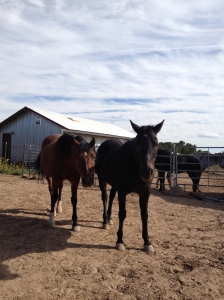
Trainers who can draw from a variety of backgrounds are preferable to those who are stuck in one method. From experience I know that when I have become rigid about a “way,” then I am not as effective. Therefore I continue my study of many horsemanship schools and my work is not a method, but a culmination of my years with horses and the teachings of the great horsemen and women I’ve had the privilege of working with, plus my own individual creativity and intuition.
All horses are different so a different approach may be needed for each, and some horses are really challenging. I’m not fond of methods that include extremely repetitive “drilling,” chasing a horse, jerking on a leadline, restraining a horse unnecessarily. If a horse becomes resistant, then my inclination is to back off and find another way. Think about it: if you are in a relationship with someone and they are always forceful, how agreeable are you to their demands? If we embody liberty training in the horse, then he will have less reason to want to be resistant, or move away from us, and therefore there is less human reason to tie him or use restraints in work in hand or riding.
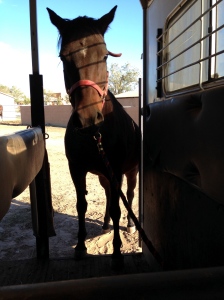
Obviously, not everything can be accomplished at liberty with a horse. But the same feel and freedom can be carried over into work in hand and riding; the same sense of choice. You are “asking” the horse to engage with you, much like you would ask another person if they would like to have lunch with you, rather than demanding that they do so.
Consequently, the horse feels “met” in the relationship, and there is so much more space for him to make necessary changes and find his own way, without coercion.
I must say that among the trainers I have worked with, some of the finest have been the horses themselves. Horses will give me an honest answer, not always the one I want, but it is honest and true.
*****
Services: Bodywork (Ortho-Bionomy for people, Equine Positional Release/Equine Ortho-Bionomy): private sessions, tutorials, phone consultations, distance healing communication and gift certificates
Liberty Training: clinics, mini-clinics, workshops, private and semi-private sessions, tutorials, consultations: by appointment: 505.501.2478 or emailing susansmith@orthohorse.info
Looking forward to Fall Lessons – semi-private, private and small group sessions. Scheduling now. We have small groups and privates scheduled for Santa Fe and Corrales and El Dorado currently. Contact me for details.
If you are interested in learning more about Equine Positional Release (Equine Ortho-Bionomy) bodywork, an upcoming weekend clinic October 26-27th will be held in Santa Fe, taught by EPR (Equine Positional Release) founder, Zarna Carter:
EPR II offered by instructor Zarna Carter
OrthoHorse Tutorials will be offered on the 2014 schedule.
Fascinating article on Ortho-Bionomy: Better than a pain pill? PostIndependent.com
Copyright (c) Susan Smith, OrthoHorse, Horses at Liberty Foundation Training



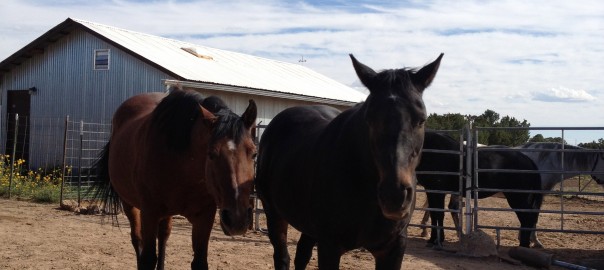
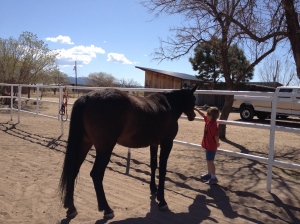
2 thoughts on “Just got my horse back from the trainer and…”
Comments are closed.